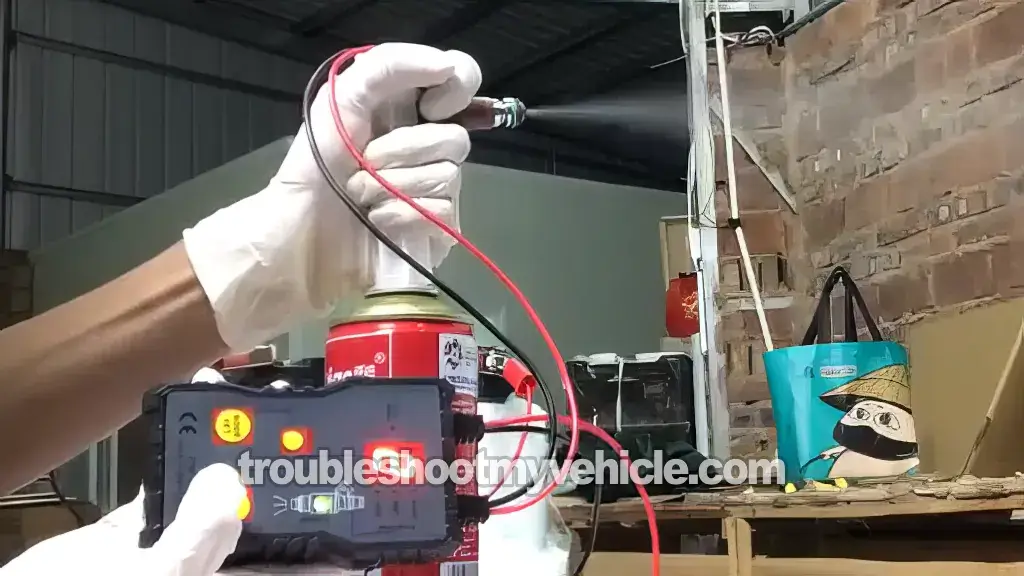PART 2: Checking The Fuel Injector Spray Pattern

For our last test, we need to visually check if the 'dead' cylinder's fuel injector can properly spray fuel. This will require you removing it and using a specialized tool kit.
This tool kit comes with two key items:
- A 12 Volt power module that pulses the fuel injector, simulating the function of the fuel injection computer.
- An adapter that attaches the fuel injector to a brake cleaner spray can.
After connecting the fuel injector to the brake cleaner and the power module, you can activate it to observe the fuel injector's actual spray pattern (that is, if it actually sprays anything).
If the fuel injector sprays in a fine mist spray pattern, you've got a working injector. If it's not a fine mist, the injector is clogged and the tool kit can help you clean it.
If the injector fails to spray at all, it’s time for a replacement. It’s that straightforward!
You can purchase the took kit here:
- QX Fuel Injector Tester & Adapter for Diagnosis and Cleaning of Injectors DIY Cleaning Tool Kit (at: amazon.com).
- EM276SET Fuel Injector Tester & Adapter DIY Cleaning Tool Kit Set (at: amazon.com).
IMPORTANT: Before installing the same or new fuel injector back on the fuel injector rail, take a look at: Important Tips For Installing A Fuel Injector.
CAUTION: Use safety glasses when performing the fuel injector cleaning procedure.
Alright, these are the test steps:
- 1
Remove the fuel injector.
- 2
Connect the fuel injector to the plastic adapter.
NOTE: I've found that securing the fuel injector to the adapter with a thick rubber band helps to make the whole process easier and less messier. - 3
Connect the fuel injector to the tool's power module.
NOTE: Follow the tool's safety and recommended set-up instructions. - 4
Connect the cleaning kit's power module to your pickup's battery.
- 5
Connect the fuel injector/adapter to a spray can of brake cleaner and press them onto the spray can.
- 6
Activate the power module.
- 7
The fuel injector should spray fuel in a fine mist and in a conical shape.
Let's interpret your test result:
CASE 1: The fuel injector did not spray at all. This tells you that the fuel injector is bad and needs to be replaced.
CASE 2: The fuel injector sprayed the brake cleaner in a fine mist and in a conical pattern. This tells you that the fuel injector is OK.
CASE 3: The fuel injector sprayed the brake cleaner in a squirt or a stream (not in a fine mist). This tells you that the fuel injector is dirty/clogged.
Continue cleaning the fuel injector until it starts to spray in a fine mist. If the cleaning it doesn't restore the injector's spray pattern to that of a fine mist, you'll need to replace it.
Important Tips For Installing A Fuel Injector
When you're done with your tests and installing either the same or a new fuel injector back on the fuel injector rail, it's important to follow these tips:
- Use New Fuel Injector O-Rings: It's super important that you replace the O-rings with new ones when installing the fuel injector, even if it's the same one. The new O-rings will ensure a good seal and prevent gasoline and vacuum leaks.
- Lubricate The O-Rings With Engine Oil: Apply a thin layer of clean engine oil (5W-30 or lighter) to to the O-rings (to lubricate them) before installing the fuel injector back on the fuel injector rail and intake manifold. This lubrication will make for easier to insert the fuel injector and to avoid damaging the O-rings.
Avoid silicone-based grease or other lubricants, a 5W-30 or lighter is the lubricant indicated in the Ford factory repair manual. - Replace Broken Fuel Injector Connectors: Ford fuel injector connectors are prone to breakage (it's so bad, it's criminal). If the connector is damaged, replace it while you have easy access.
- Soldering Versus Butt Connectors: When replacing a connector, solder the new connector's wires to the engine wiring harness for a permanent and reliable connection. Avoid using butt connectors, as they can loosen over time and cause an open-circuit problem.
Remember, the goal is to prevent gasoline leaks and avoid the risk of fire. Take your time to ensure everything is properly seated and secure.
More 4.6L Crown Vic And Grand Marquis Tutorials
There are quite a few 4.6L Ford Crown Victoria (Mercury Grand Marquis) 'how to' tutorials and wiring diagrams in this index:
E-Series Vans: You can find all of the available tutorials and wiring diagrams for the 4.6L and 5.4L V8 E-Series vans in this index:
F-Series Pickups: You can find all of the available tutorials and wiring diagrams for the 4.6L And 5.4L V8 F-Series pickups in this index:
- 4.6L, 5.4L Ford F150, F250, And F350 Index of Articles (at: easyautodiagnostics.com.com).

If this info saved the day, buy me a beer!

